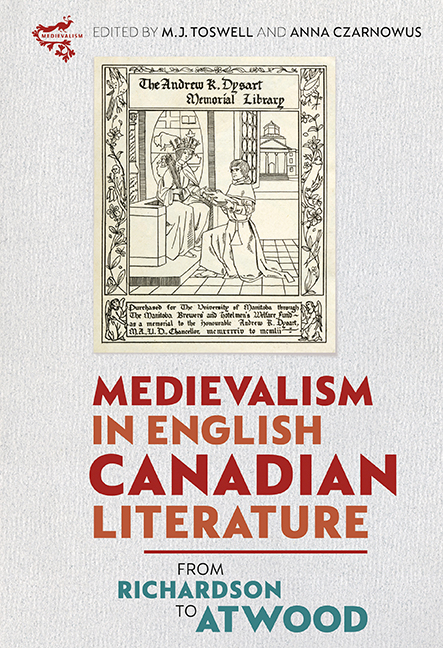Book contents
- Frontmatter
- Contents
- Introduction: English Canadian Medievalism
- 1 “Men of the North”: Archibald Lampman's Use of Incidents in the Lives of Medieval Monarchs and Aristocrats
- 2 “Going Back to the Middle Ages”: Tracing Medievalism in Julia Beckwith Hart's St. Ursula's Convent and John Richardson's Wacousta
- 3 John Richardson's Wacousta and the Transfer of Medievalist Romance
- 4 A Canadian Caliban in King Arthur's Court: Materialist Medievalism and Northern Gothic in William Wilfred Campbell's Mordred
- 5 Orientalist Medievalism in Early Canadian Periodicals
- 6 The Collegiate Gothic: Legitimacy and Inheritance in Robertson Davies's The Rebel Angels
- 7 Earle Birney as Public Poet: a Canadian Chaucer?
- 8 “That's what you get for being food”: Margaret Atwood's Symbolic Cannibalism 129
- 9 Lost in Allegory: Grief and Chivalry in Kit Pearson's A Perfect, Gentle Knight
- 10 Remembering the Romance: Medievalist Romance in Fantasy Fiction by Guy Gavriel Kay and Charles de Lint
- 11 Medievalisms and Romance Traditions in Guy Gavriel Kay's Ysabel
- 12 The Medieval Methods of Patrick DeWitt: Undermajordomo Minor
- Index
- Miscellaneous Endmatter
6 - The Collegiate Gothic: Legitimacy and Inheritance in Robertson Davies's The Rebel Angels
Published online by Cambridge University Press: 25 March 2020
- Frontmatter
- Contents
- Introduction: English Canadian Medievalism
- 1 “Men of the North”: Archibald Lampman's Use of Incidents in the Lives of Medieval Monarchs and Aristocrats
- 2 “Going Back to the Middle Ages”: Tracing Medievalism in Julia Beckwith Hart's St. Ursula's Convent and John Richardson's Wacousta
- 3 John Richardson's Wacousta and the Transfer of Medievalist Romance
- 4 A Canadian Caliban in King Arthur's Court: Materialist Medievalism and Northern Gothic in William Wilfred Campbell's Mordred
- 5 Orientalist Medievalism in Early Canadian Periodicals
- 6 The Collegiate Gothic: Legitimacy and Inheritance in Robertson Davies's The Rebel Angels
- 7 Earle Birney as Public Poet: a Canadian Chaucer?
- 8 “That's what you get for being food”: Margaret Atwood's Symbolic Cannibalism 129
- 9 Lost in Allegory: Grief and Chivalry in Kit Pearson's A Perfect, Gentle Knight
- 10 Remembering the Romance: Medievalist Romance in Fantasy Fiction by Guy Gavriel Kay and Charles de Lint
- 11 Medievalisms and Romance Traditions in Guy Gavriel Kay's Ysabel
- 12 The Medieval Methods of Patrick DeWitt: Undermajordomo Minor
- Index
- Miscellaneous Endmatter
Summary
AT THE BEGINNING of Robertson Davies's 1981 novel The Rebel Angels, Professor Clement Hollier reveals to his doctoral student and one of the novel’s narrators, Maria Magdalena Theotoky, that Francis Cornish, “the foremost patron of art and appreciator and understander of art this country has ever known,” had died that morning. Cornish's extensive collection of Canadian art is destined for the National Gallery, but “he was also a discriminating collector of books,” and as executor of his will, Hollier knows that “they go to the University Library”. Hollier then informs Theotoky that Cornish “was also a not-so-discriminating collector of manuscripts; didn't really know what he had, because he was so taken up with the pictures he hadn't had much time for other things. The manuscripts go to the Library, too” (3). This is the reason why Hollier wants Theotoky to work near him during the coming academic year: “one of those manuscripts will be the making of you, and will be quite useful to me, I hope” (3). Moreover, he tells her, “that manuscript will be the guts of your thesis, and it won't be some mouldy, pawed-over old rag of the kind most students have to put up with. It could be a small bombshell in Renaissance studies” (3–4). Theotoky, of course, wants to know more: “What was this manuscript about which he was so evasive?” (4).
When I first read this scene as an undergraduate, I was taken in by the intellectual excitement that manuscript studies seemed to offer. When I reread it as a graduate student learning to study manuscripts, I was convinced that other students had bombshells in their hands while I was pawing over mouldy old rags. Rereading this scene recently, I noticed something very different about it. Whereas Maria Theotoky is curious to know what is in the manuscript, the novel's structure revolves around other questions: where is the manuscript and who has the best claim to study it? This essay begins by answering these questions in a fairly straightforward manner, recognizing that The Rebel Angels may not be widely known. It then explores the concept of the “Collegiate Gothic” as both an architectural style and a description of the novel's genre before considering how the novel explores questions pertaining to legitimacy, inheritance, and national identity.
- Type
- Chapter
- Information
- Medievalism in English Canadian LiteratureFrom Richardson to Atwood, pp. 97 - 112Publisher: Boydell & BrewerPrint publication year: 2020
- 1
- Cited by



